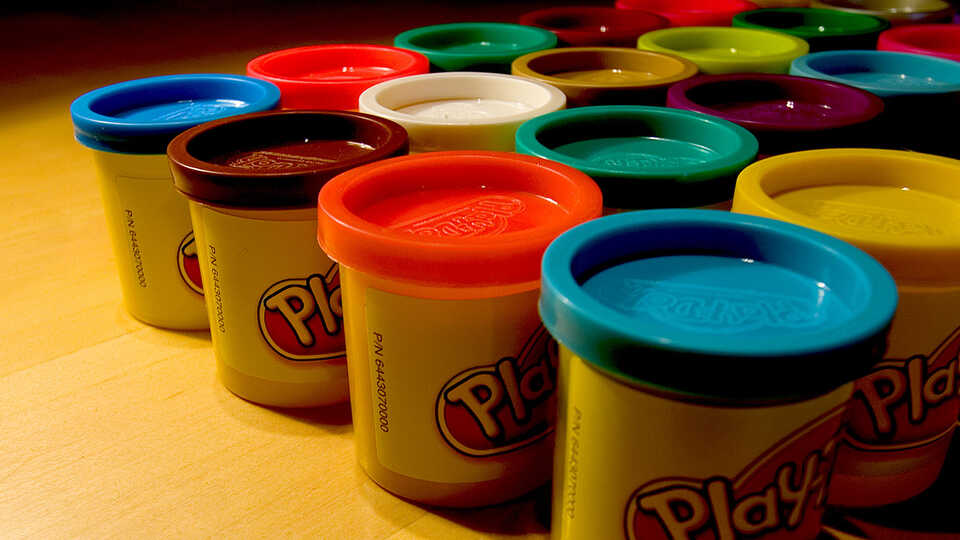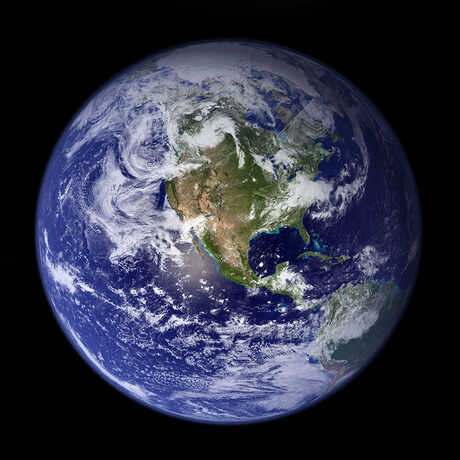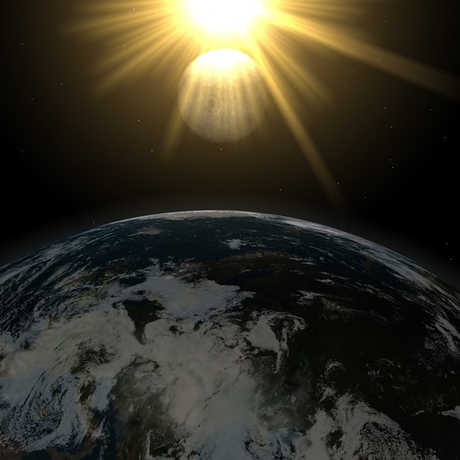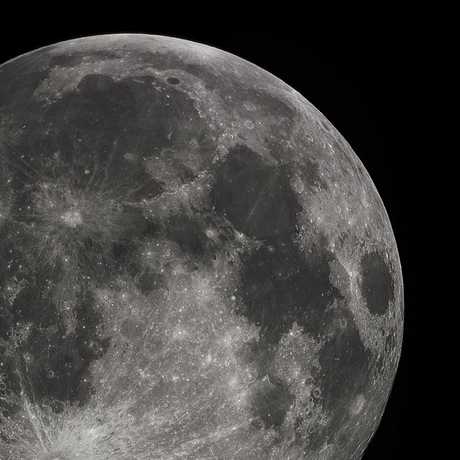
© Dennis Brekke
Do you know the relative sizes of the moons in our solar system? Put yourself to the test with some Play-doh. Size comparisons between moons and their planets can be surprisingly tricky. This activity allows students to model, in three dimensions, the relative sizes of the moons and their planets.
In this activity students will:
- model the relative sizes of Earth, Mars and Jupiter and their largest moons.
- play-dough (three pounds or about 10 containers per group)
- plastic knife (one per group)
- wax paper (one sheet per group)
- student worksheets (one set per group)
- instructions (one per group)
- Try the activity for yourself before leading it.
- This activity can stand alone, or can come after doing “Kinesthetic Astronomy” and “Modeling Eclipses with Size and Distance Scales.”
- Gather materials. Teacher Tip:
- This activity works best if the worksheets with the planet and moon names (pages 6 – 8) are placed side-by side on a table, and are arranged to match the order of planets from the Sun.
- Be sure there is enough room in front of the table for the group to work together.
- It is crucial to have the indicated amount of play-dough for each group. If there is less than three pounds, Mars’s moons (Phobos and Deimos) will be too small to see!
- For any scale model activity, it is useful to start by exploring the notion of models. Playthings, such as dolls or toy cars, can be a useful reference for talking about scale models.
- Begin by asking students: How big is the Moon compared to Earth? Might it be 1/2 or 1/4 for example? Why do you think that?
- Then ask: Which planet’s moon(s) do you think is/are the largest: Mars, Jupiter or Earth? For whatever planet they say is the largest (it will most likely be Jupiter), ask them the following question: How big do you think the largest moon of that planet is compared to it? Might it be 1/4 or 1/10, for example? Which is the smallest?
- Have students explain their thinking.
- End by telling them they will get a better idea of these relative sizes or volumes after completing this activity.
Start by reading the instructions handout. Students should get into working with the play-dough as quickly as possible.
INSTRUCTIONS
- Divide the Entire Ball of Play-dough into 10 Equal Parts You may find it easiest to start by rolling the ball into one big hot dog shape.
- Combine 9 parts together and put them into the Jupiter box.
- Cut the Remaining Part into 10 Equal Parts
- Take 9 parts and combine them with the ball in the Jupiter box.
- Cut the Remaining Part into 10 Equal Parts
- Take 9 parts and combine them with the ball in the Jupiter box.
- Cut the Remaining Part into 10 Equal Parts
- Take 4 parts and combine them with the ball in the Earth box.
- Put 1 part into the Mars box.
- Take 4 parts and combine them with the ball in the Jupiter box.
- Cut the Remaining Part into 10 Equal Parts
- Put 1 part into the Io box.
- Put 1 part into the Moon box.
- Put 1 part into Europa box.
- Take 3 parts and combine them into a ball in the Ganymede box.
- Take 2 parts and combine them into a ball in the Callisto box.
- Take 2 parts and combine them with the ball in the Jupiter box.
- Find 2 left over specks of Play-dough Specks should be size of a grain of salt
- 1 speck will be Phobos
- 1 speck will be Deimos
- Put specks into the Phobos & Deimos box.
- Finally: Now that you have divided the play-dough to represent the planets by volume, roll the pieces in each planet’s box into balls to best represent the shapes of the planets.
Follow the instructions as to how to divide up their play-dough, placing the parts in the proper planet or moon boxes. Each time the play-dough is divided up and parts are combined to make a planet or moon, be sure students roll the combined parts around in their hands until the planet has a ball shape. As seen in the images on the next page.
- Ask the group about some of the discoveries they made regarding the sizes of the planets and moons. Were there any surprises? Ultimately direct the discussion so that they come to the conclusion that size of the planet does correlate with the size of its moon(s). Asking questions like:
- Which planet has the biggest moon(s)?
- Which planet has the smallest?
- Be sure to remind your students that they were looking only at 3 planets with moons, but that there are other planets in our solar system that have moons as well.
planet: In the solar system, a planet is a large round object that orbits the Sun and has cleared out most of the other objects in its orbit.
moon: A natural object that orbits a larger object.
solar system: The Sun and all of the planets, comets, moons, etc. that revolve around it.
This activity leads students to explore the concepts of size using 3-dimensional models to understand the relative sizes of some of the moons and their planets. Students begin with thinking about their own internal mental models, then create a model of these objects.
Scientists develop and use models in order to explore how systems work. They can help make a concept that is hard to see become visible. The Next Generation Science Standards state that by the end of 5th grade, students should be able to use models to describe and/or predict phenomena. Additionally, the standards also mention that students should be able to “identify the limitations of models.”
For this model, if you strictly convert the size of the planets and their moons, students would be cutting in 1/16th and 1/8th s . Therefore we rounded the fractions of volume so students will be able to have an easier time dividing their volumes.
Common Misperceptions
Models and illustrations of the Solar System often misrepresent the true scales and distances involved. The difficulty lies in the vast difference between the relative sizes of planetary bodies and the distances between them. For example, an accurate model using a 1” sphere to represent the Sun results in a distance to Pluto of over 350 feet (more than a football field away), and most of the planets would appear no larger than tiny specks.
It is usually beneficial to address these two dimensions separately, using one model to compare the sizes of the planets and their moons, and another to illustrate their relative distances from the Sun and each other. By combining this activity with the activity “Pocket Solar System”, teachers can address the misconceptions prevalent in our depictions of the Solar System.
Size comparisons between planets and their moons can be surprisingly tricky. Many illustrations of the planets and their moons do not correctly represent their proper relative sizes, often showing the inner planets as much too large relative to the outer ones. To depict things correctly, for example, it would take 11 copies of Earth to stretch across the full diameter of Jupiter. And while this can be easily illustrated (we do it this way in our planetarium programs), it is still a 2-dimensional representation that does not fully capture the difference in volume between these objects.
This activity is adapted from the Worlds in Comparison lesson originally developed by Dennis Schatz, Pacific Science Center, and further adapted by Anna Hurst, Astronomical Society of the Pacific, 2008.
Science and Engineering Practices
- Developing and Using Models
- Develop and use models to describe phenomena
- Using Mathematics and Computational Thinking
- Apply mathematical concepts and/or processes to scientific and engineering questions and problems
Disciplinary Core Ideas
- ESS1.B: Earth and the Solar System: The solar system consists of the sun and a collection of objects including planets, their moons, and asteroids that are held in orbit around the sun by its gravitational pull on them.
Cross-Cutting Concepts
- Scale, Proportion and Quantity
- Time, space and energy phenomena can be observed at various scales using models to study systems that are too large or too small.
- Systems and System Models
- Can describe a system in terms of its component and their interactions
- Models can be used to represent systems and their interactions.
The activity outlined here is just one step toward reaching the Performance Expectations listed below. Additional supporting materials and lessons will be required.
MS-ESS1-3: Analyze and interpret data to determine scale properties of objects in the solar system


